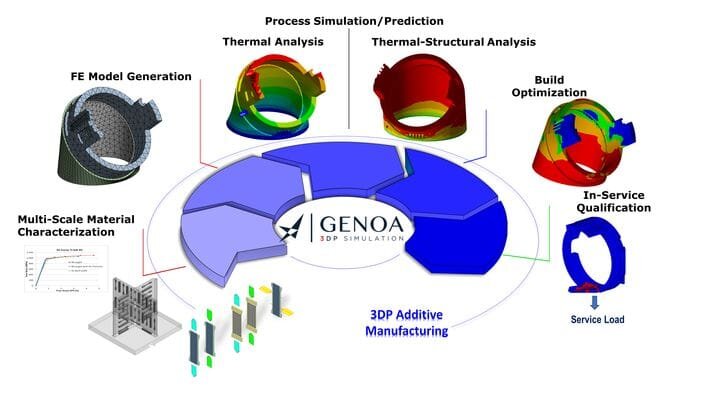 Alphastar’s Genoa 3DP Simulation Suite
Alphastar’s Genoa 3DP Simulation Suite
SPONSORED CONTENT
I’m looking at AlphaSTAR’s GENOA 3DP simulation suite, a tool for assisting professional additive manufacturing production.
I’ve been working in additive manufacturing / 3D printing for over 12 years, and I am still constantly surprised by the complexity of the additive manufacturing, and the consequent challenges facing equipment operators.
This is particularly evident in powder-based additive manufacturing processes such as SLS, DLMS and EBM, where environmental characteristics can hamper achievement of successful prints unless all factors are precisely balanced.
For example, in metal 3D printing processes, tremendous heat is applied when lasers sinter the fine metal powder. This heat is significantly higher than that of surrounding powder, creating a rather large heat gradient that can create damaging forces within the print. In many cases these forces can cause warped parts, dimensional inaccuracies and even cracks, all not good.
Sometimes the flaws do not appear until after the print completes; when the support structures are cut off, forces that cause part distortion are suddenly released. As you can tell, it’s a highly complex subject that requires considerable skills to navigate. This is why many metal additive manufacturing operations employ a large squad of engineers, as they typically have to determine these effects and resolve them.
It’s no longer a game where just being able to “make something” is sufficient; in order to make parts of production quality, extraordinary steps must be taken to ensure all print jobs succeed. Production parts must always be within tolerance requirements and produced consistently at that quality each and every time.
With the increasing focus on production parts made using additive manufacturing by industry, it is no surprise there is an increasing need for print quality and efficiency solutions. Part quality is for many operations, the number one concern: if the part does not meet specifications, then the clients will not accept them.
One approach for doing so is, obviously, experimentation through trial and error. This is a method undertaken by many additive manufacturing operations. Trial and error does work, eventually, but there are tremendous costs incurred by doing so. Failed attempts waste machine time, engineers’ time and of course, 3D printer powder, all of which are incredibly valuable.
![Heat chamber simulation in Genoa 3DP Simulation Suite [Source: Alphastar]](https://www.fabbaloo.com/wp-content/uploads/2020/05/image-asset_img_5eafb32cc3c24.jpg)
Another solution is the idea of simulation: in software simulate in great detail all factors present during each stage of a print job. This allows an operator to tune the print parameters to optimal levels without actually printing, and can greatly reduce waste and expense over other approaches.
Simulation is one of the main features of AlphaSTAR’s GENOA 3DP product. Their software uses a unique multi-physics approach that employs nano, micro and macro mechanics to generate detailed simulations of 3D print jobs. GENOA 3DP’s multi-dimensional approach can provide a highly accurate prediction of what will occur in the build chamber.
![Bald spot detection in the Genoa 3DP Simulation Suite [Source: Alphastar]](https://www.fabbaloo.com/wp-content/uploads/2020/05/image-asset_img_5eafb32ce13c6.jpg)
GENOA3DP is a suite of tools that assists each stage of analysis of an additive manufacturing job. It begins with material characterization, where the as-built properties, including effect of defects, of the selected material is captured and incorporated into the analysis. Then, GENOA 3DP Path Coverage module can be called upon to identify inefficiencies in the geometry and provide an optimized model.
GENOA 3DP analyzes GCODE for a given print job to extract the print parameters and then goes to work performing a detailed, layer-by-layer, multi-physics simulation process involving both time, temperature and other aspects.
![Left: NASA Chamber Liner (Inconel 718). Right: 3D Visualization of Calculated Bald Spot Percentage from AM SimQ [Source: Alphastar]](https://www.fabbaloo.com/wp-content/uploads/2020/05/genoa-warp-prediction_img_5eafb32d08822.jpg)
GENOA 3DP’s simulation can predict voids, net-shape, residual stress, crack growth and other anomalies that can occur during powder printing operations, any of which might result in a failed print. This allows an operator to experiment with parameters to develop a likely successful combination before committing to an actual physical print.
This is essentially a virtual recreation of an AM build, including any anomalies that might occur. The predictions of defects can be interpreted by the operator to make adjustments for the next simulation, gradually dialing in the parameters for the perfect build.
It should be noted that software recognizes sensitivity of each parameter setting in relation to build outcomes and may be used with Design of Experiments (DOE) optimization techniques to identify optimal parameter settings that reduce or eliminate unwanted phenomena.
![Screenshot of Genoa 3DP Simulation Suite [Source: Alphastar]](https://www.fabbaloo.com/wp-content/uploads/2020/05/genoa3dp-screenshot_img_5eafb32d25a5f.jpg)
I’m not certain of AlphaSTAR’s pricing for Genoa 3DP, but it is highly likely additive manufacturing operations will receive payback in short order by avoiding expensive print failures and saving precious engineers’ time. Even a single print failure can be incredibly costly, so avoiding them warrants considerable attention, and avoiding many of them could be quite profitable.
AlphaSTAR explains the key features of Genoa 3DP:
-
Supports metal powder and polymer material systems – validated material databases for Metals/Polymers/Ceramics
-
Predicts mechanical properties with voids and anomalies at room and elevated temperatures
-
Assesses both material and process parameter sensitivities to be optimized to improve manufacturing process
-
In-service qualification of printed part, effect of voids and defects on in-service life, strength and durability
-
Predicts manufacturing anomalies (e.g. residual stress, warpage, heat affected zone, delamination, etc.)
-
Visualizes/Assesses printer path quality and highlights problematic bald spots, 2D/3D voids visualization
-
Creep diffusion model to predict local anomalies, voids and local surface roughness
-
Predict transient temperature & material phase/states – Zeroth Order Model for Thermal Analysis (ZOM)
-
Predict damage failure/type location, and percentage of contribution of each failure type to fracture
There are other simulation tools on the market, but I doubt any have quite as comprehensive a suite of function as is found in GENOA 3DP. If your additive manufacturing operation involves metal, thermoplastic or ceramic powder, you definitely should take a close look at AlphaSTAR’s GENOA 3DP simulation suite.
Via AlphaSTAR
